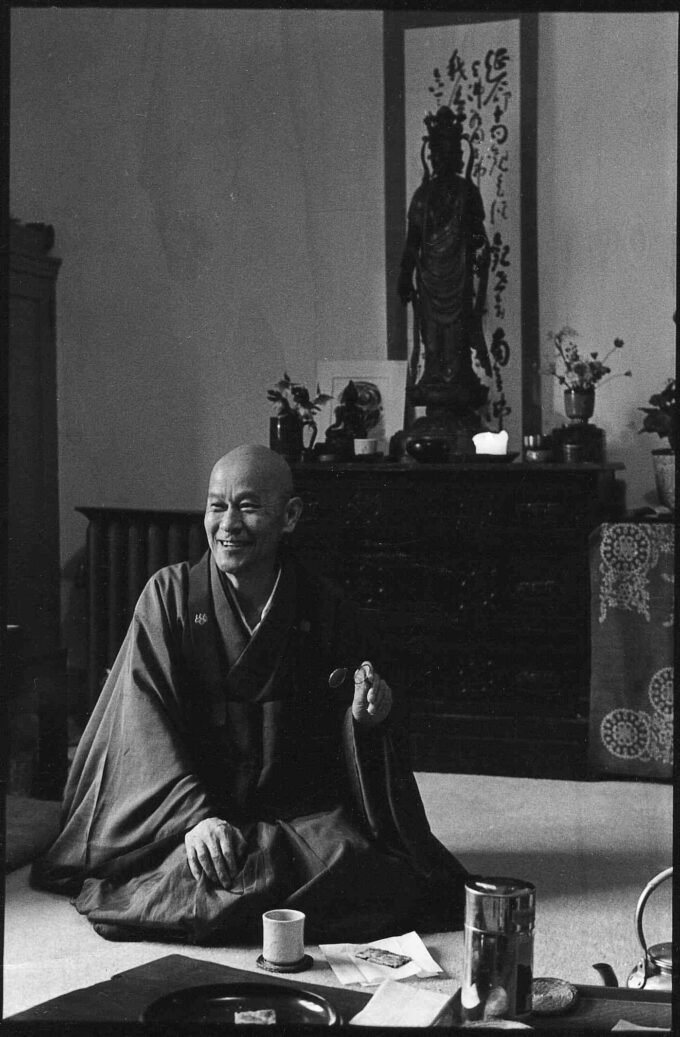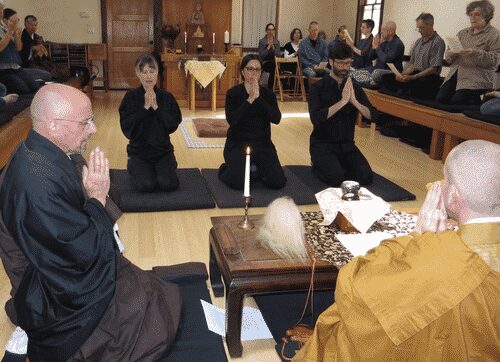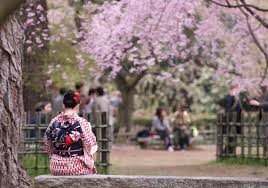18-th of May 1904, the year of the dragon and the 37th year in the reign of Emperor Meiji, Shunryu Suzuki is born at Shogan-ji temple. Shunryu Suzuki was born as Toshitaka Suzuki, in a small village near Hiratsuka in Kanagawa Prefecture. His father, Sogaku Suzuki, was head abbot of the temple. His mother was the daughter of a Zen priest. At birth, he is given the Buddhist name Shunryu (Excellent Emergence) by his father.
In 1916 Suzuki started to train with a former disciple of his father, Gyokujun So-on Suzuki. So-on was Sogaku’s adopted son, and abbot of Sokagu’s former temple Zoun-in. After one year, is ordained as a novice monk by Gyokujun So-on, and is given his second Buddhist name, Shogaku (Auspicious Peak) – but he also received a nickname from So-on – Crooked Cucumber – because of his forgetful and unpredictable nature. In 1918, So-on was made head of a second temple, called Rinso-in. Shunryu followed him there. During the next years, So-on sent him to train with a Rinzai master. There Shunryu studied a very different kind of Zen, one that promoted the attainment of satori through the concentration on koans through zazen. In 1919, he went back to his parents house, and entered the middle school. In 1924 Shunryu enrolled in a Soto preparatory school in Tokyo.
From 1925 to 1926 Suzuki did Zen training with Dojun Kato in Shizuoka at Kenko-in. He continued his schooling during this period. Here Shunryu became head monk for a 100 day retreat, during which he has completed his training as a head monk.
In 1930, graduates from Komazawa University second in his class, with a major in Buddhist and Zen Philosophy and a minor in English. Upon graduation, So-on wanted Shunryu to continue his training at the well known Soto Zen temple – Eiheiji. In September of 1930 Suzuki entered the training temple and underwent the Zen initiation known as tangaryo. In December, Suzuki sat his first true sesshin for 7 days. This concluded his first practice period at Eiheiji.
In September of 1931, after one more practice period and sesshin at Eiheiji, So-on arranged for Suzuki to train in Yokohama at Sojiji. Sojiji was the other main Soto temple of Japan, and again Suzuki underwent the harsh tangaryo initiation. In 1932, Suzuki left Sojiji and moved back in to Zoun-in.
In 1932, starts as Zen teacher (koshi) in Bansho Zenrin, Kasuisai, Kukuroi-shi, Shizuoka-ken. (Part of responsibilities for Rinso-in, where he remains living.)
In 1942 starts as official director or Zen teacher (shike/daho) of Tokei-in temple: 10th highest monastery of Soto sect. Formally becomes roshi for ceremonial purposes.
Suzuki-roshi was asked to go to America to assist Hodo Tobase at Soko-ji. He declined. But, in 1959, at 55 years of age, he leaves for San Francisco.
***
“On May 23, 1959, Shunryu Suzuki (then age 55) came from Japan to San Francisco to serve as head priest of Sokoji—a Soto Zen temple then located at 1881 Bush Street in Japantown. He was joined by his wife Mitsu (also from Japan) in 1961. Sokoji—founded by Hosen Isobe in 1934—had been housed in a former Jewish synagogue that is now Kokoro Assisted Living. Upon Suzuki’s arrival at Sokoji, the congregation was composed entirely of members of the Japanese-American population. Unlike his predecessors, Suzuki was a fluent speaker of English who actually wanted to come to the United States. Suzuki’s arrival came at the tail end of the Beat movement and just prior to the social movements of the 1960s, both of which had major roots in San Francisco. Before long, Sokoji had non-Japanese Americans — mostly beatniks— coming to the temple to sit zazen with him in the morning. Soon these Westerners participated in regular services, and new non-Asian students came to outnumber the Japanese-American congregation. This change in demography caused a rift in the Sokoji community. The tension was alleviated when Suzuki’s Western students began gathering for separate services, albeit still at Sokoji, in 1961. Some of these students began calling their group City Center, and they incorporated in 1962 as the San Francisco Zen Center (SFZC).
The number of practitioners at SFZC grew rapidly in the mid-sixties. Within a couple of years, Suzuki considered founding a monastery to host more intensive practice for those students who were interested. In 1966, Suzuki and Baker scouted Tassajara Hot Springs, located in Los Padres National Forest behind Big Sur, as a possible location for the envisioned monastic center. After a major fundraising effort led by Baker, Zen Center purchased the land—which contained a rundown resort and mineral springs in 1967. Tassajara Zen Mountain Center (“Zen Mind Temple” or Zenshinji) was the first Zen Buddhist monastery built in the United States, and the first in the world to allow co-ed practice.” (source: wikipedia)
***
In 1969 Suzuki Roshi resigned his position as a priest at Sokoji to focus on teaching Zen to Americans. He moved to a large residential building, which became known as the City Center. Suzuki Roshi died of cancer on December 4, 1971. He was 67 years old. Although he stayed in the United States for only 12 years, he had done a great work to establish Soto Zen in America. It is for sure that the success is due to his magnetic personality and to his style of teaching, which emphasized a simple practice of “just sitting” with a “beginner’s mind” and daily living based on Zen principles.
Shunryu Suzuki was one of the most influential spiritual teachers of the twentieth century and is truly a founding father of Zen in America. In fact, Suzuki Roshi was one of the most influential Zen teachers of his time. His teachings flow from the Soto lineage of Zen Buddhism, founded by Dogen Zenji (1200-1253) in thirteenth-century Japan.
He was the founder of the San Francisco Zen Center and the Tassajara Zen Mountain Center. He is the author of Zen Mind, Beginner’s Mind and Branching Streams Flow in the Darkness: Zen Talks on the Sandokai, and he is the subject of the biography Crooked Cucumber by David Chadwick.
Now, forty years after his death, Suzuki Roshi’s immediacy as a teacher continues: in books, audio recordings, and the photographs, films, and letters that survive. Most of all, his teaching continues in the memories and teachings of those who studied with him.
His students continue to teach at the Zen Center and in dharma groups around the country. Today there are over 60 zen centers and groups in North America continuing the Shunryu Suzuki-roshi lineage of Soto Zen Buddhism.
QUOTES
Maybe I am a very smoky kerosene lamp [kerosene lamps were used to light the zendo]. When I start to talk about something, it is already a smoky kerosene lamp. As long as I must give a lecture, I have to explain in terms of right and wrong: “This is right practice, that is wrong, this is how to practice zazen.” It is like giving you a recipe. It doesn’t work. You cannot eat a recipe.
************
As Dogen says, people like what is not true and they don’t like what is true.
************
You may foolishly try to ignore karma, but this will never work, and if you fight it too much, you will invite destruction that is worse than war. We are actually creating war through our everyday activities. You talk about peace in some angry mood, when actually you are creating war with that angry mood. Ughhh! That is war! We should know. We should open our dharma eyes, and together we should help each other forever.
************
The secret of Soto Zen is just two words: not always so.
************
There is nothing absolute for us, but when nothing is absolute, that is absolute.
************
Enlightenment is not any particular stage that you attain.
************
• Paradoxically, I am writing about how “I” came to Experience the Fact/Reality that “I” do not actually exist. (Not as a Separate Entity, not as a Separate Self, not independent of “you,” “computer,” “desk,” “Sun,” “Universe,” etc.)
•Ultimately, (precisely Literal not metaphorical or figuratively, but Truly) there really is No “Me” to describe “About Me.”
There is still Form, Feeling, Perception, Consciousness, & Object of Consciousness.
•Another paradoxic, is how now “I” or “Not I” am Here (or not here! …okay, okay… now I am just having fun with you (And FYI, no, I say: I without quotation marks, nor do I go around using “air quotes” all the time! :~)}
Hahahahaaah! aaahhh! • B R E A T H E!!• It’s ALL. So. Damn. FUNNY! Killer Irony..the ultimate Mind-Blowwer!




